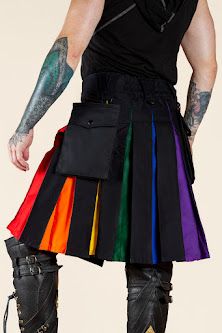The Scottish Kilt: significantly better than the rest.. also the knee!
Whenever you ponder Scottish practices, I believe any reasonable person would agree that the Scottish kilt would be one of the absolute first to come into view. Yet, do you have at least some idea why the unmistakable plaid thing is the staple of a decent Scot's wedding, where it started from for sure the various shadings and examples address? Above all, do you have any idea about what accomplices to style your Scottish kilt with so you can mix in up in the Highlands?
We have attempted to address this multitude of inquiries and the sky is the limit from there, just read on to discover…
The History of the Scottish Kilt
The main record of the Scottish kilt is from the sixteenth century, and this was the extraordinary kilt, the breacan or belted plaid, which was a full-length article of clothing whose upper half could be worn as a shroud, pulled up over the head or hung around the shoulder.
Preceding the improvement of the Kilt as far as we might be concerned today, there was a thing of apparel known as a "whelp" or woolen shroud (otherwise called a plaid) which was worn over a tunic. This previous shroud might have been plain in shading or in different check or plaid plans, contingent upon the abundance of the wearer. Throughout the span of the sixteenth century, as fleece turned out to be all the more promptly accessible, this shroud developed to such a size that it started to be gotten together and belted, and this was the beginnings of the extraordinary kilt.
This image shows a Highland clan leader wearing one of the earliest sort of Scottish kilt, the belted plaid, in 1680.
This image shows a Highland clan leader wearing one of the earliest sort of Scottish kilt, the belted plaid, in 1680.
These early Scottish kilts were multi-reason; they gave incredible security from the climate and components, they served to cover and watch weapons, for example, black powder rifles worn with regards to the individual, they could be taken out and utilized as a setting up camp cover, and they filled in as a marker of riches and status relying upon their size and material.
"The attire is surely extremely free, and fits men acclimated to it to go through extraordinary uniform, to make exceptionally speedy walks, to substantiate against the nastiness of the climate, to swim through streams, and asylum in hovels, woods, and rocks upon event; what men wearing the low nation clothing couldn't really persevere."
Portrayal from 1746.
This kind of kilt was as yet in inescapable use until the nineteenth century, and truth be told there are the people who actually sport one today, albeit normally similarly as formal wear. Yet, it was at some point in the late seventeenth or mid eighteenth century that the little kilt began to come into utilization. The little kilt is an improvement from the extraordinary kilt, being basically its base half, utilizing a solitary width of material worn hanging out cowardly.
It was around this time that Highlanders detailed the extraordinary kilt to be as well "cumbrous and clumsy" for their work and in fight, thus the similarly unmistakable little kilt was created, to be made of the lower half of the belted plaid with the creases previously sewn in.
The custom fitted kilt was taken on by the Highland regiments of the British Army, and the tactical kilt and its formalized adornments passed into regular citizen use during the mid nineteenth century and have stayed well known from that point forward.
Scottish Tartan
One of the most-particular highlights of the true Scottish kilt is it's plaid design, which is otherwise called the sett.
Specific plaid designs are related with individual tribes and families, a practice that can be followed back just a couple of hundreds of years. Preceding this, Highland plaids held provincial affiliations rather than being an image of a particualr family. The arrangement of named plaids as it is realized today started to be recorded by the weaving organizations in the nineteenth century Victorian period.
In the advanced there are likewise plaids for regions, districts, social orders and organizations, as well as setts for states and regions; schools and colleges; donning exercises; people; and furthermore memorial and basic nonexclusive examples that anyone can wear.
Plaids started in woven fleece, however presently they are made in numerous different materials, and are designed fabrics comprising of confounded, flat and vertical groups in various tones.





Comments
Post a Comment